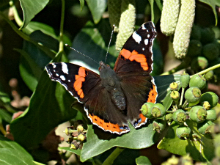%20021016_DM_43.jpg)

Red AdmiralVanessa atalantaCommon migrant/resident 
Distribution and Status The Red Admiral is our most common migrant and is widely distributed in the two counties. Numbers vary greatly year by year but there is an upward long-term trend in abundance probably because of climate warming in Europe facilitating increased migration. An increase in home-bred specimens is also a possibility due to climate warming. In addition, there is evidence of more very early sightings suggesting that overwintering by adults and larvae is more prevalent Habitat Requirements Every habitat type including parks and gardens although it is less common on arable land Larval Foodplants Common Nettle Urtica dioica. Hop Humulus lupulus and Pellitory-of-the-Wall Parietina diffusa are other foodplants reported Adult Food Sources Buddleia Buddleja davidii, Ivy Hedera helix, Iceplant Sedum spectabile. Apple fruit Malus domestica Behaviour/Observation notes Males in spring and early summer are largely territorial along woodland rides, for example, and are difficult to approach. However, in late summer and autumn, when both sexes are feeding on flowers in gardens, ivy in hedgerows or rotting fruit then they are more approachable for close-up photographs 
Life History The Red Admiral can probably now be considered as a resident species because there is ample evidence of successful overwintering in the adult stage and possibly also in an immature stage since many specimens are now seen in the early spring before the migrants arrive in May and June. The migrants and any overwintered or spring individuals will produce a new generation later in the summer, often reaching a peak in September which may be supplemented by another influx from Europe. Eggs are laid singly on the upper surface of fresh leaves most often in a sunny but sheltered spot. Larvae form silken tents using the edges of a leaf. Pupation takes places within one of these tents Further information
Photo gallery |